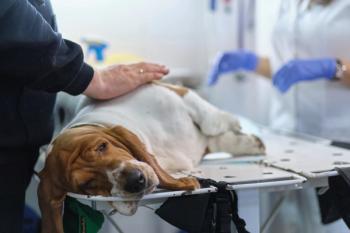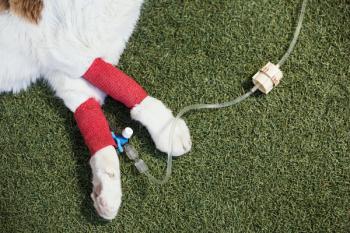
Unseen enemy
For any veterinary practice, maintaining good hygienic standards these days is much more than just a good idea.
For any veterinary practice, maintaining good hygienic standards these days is much more than just a good idea.
It's critical, experts say, with deadly drug-resistant staph infections reported on the rise among humans and animals — both inside and outside hospital settings.
Cross-transmission of methicillin-resistant Staphylococcus aureus (MRSA) places veterinarians and their staffs at greater risk of MRSA infections and increases the chance that more of them will become carriers.
Many already are — in numbers greater than the general population, based on a study by the Centers for Disease Control (CDC) during the 2005 American College of Veterinary Internal Medicine (ACVIM) Forum in Baltimore. That study found MRSA in 27 attendees out of 417, or 6.5 percent. Of the 27 positives, 15 of 96 large-animal practitioners carried MRSA (15.6 percent), as did 12 of 271 small-animal doctors (4.4 percent). (None of 50 attendees from industry or research were carriers.)
"Because of evidence of animal-to-human transmission, veterinary personnel should handle animals that are MRSA-positive with contact precautions, using gloves, gowns and environmental cleaning to prevent mechanical transmission," Dr. Katherine Quesenberry, DVM, MPh, Dipl. ABVP (avian) at New York City's Animal Medical Center (AMC), tells DVM Newsmagazine.
"The same precautions used in people to prevent MRSA should be used when dealing with pets — keeping wounds covered and using good hand hygiene in handling pets," Quesenberry says.
Veterinarians at AMC, she adds, "have not been seeing an increased incidence of MRSA. In fact, we have seen very few cases of it in the past five years. We proactively monitor to determine the incidence of MRSA."
A key reason all veterinarians and veterinary hospitals should be proactive, Quesenberry says, is that "recent reports suggest MRSA is a zoonotic pathogen that is transmitted both human-to-animal and animal-to human. This means that uninfected humans may possibly become infected with MRSA from animals.
"Animal hospitals need to become more aware of MRSA in hospital settings. Most practice good environmental cleaning, but standard precautions of using gloves or hand hygiene when handling animals to prevent fomite transmission by hospital personnel are underused in veterinary settings."
Among DVMs who are finding more MRSA infections in companion animals is Dr. Lewis Gelfand, a Long Beach, N.Y., practitioner who tells DVM Newsmagazine he's seen 26 MRSA cases in dogs in the last year, although none yet in cats.
"I've seen two in just the last three days," Gelfand says. One patient had a corneal ulcer, the other an infection on the lip. "If I'm seeing that many, other veterinarians everywhere must be, too. It can't be just in my area. This has to be rampant. This pathogen is not new. It's been around a very long time, but its resistance to various antibiotics is growing," Gelfand says.
It's logical that veterinary personnel are at increased risk of getting infected, or passing MRSA to another person or to an animal, "because we're constantly in contact with lots of people and we rub a lot of fur coats," says Gelfand, whose practice has four full-time DVMs who see about 4,000 patients a year.
Cause for concern
What does he recommend as a hygienic precaution? "Always wash your hands well, use good disinfectants and, depending on the severity of cases, wear disposable gloves between patients."
Gelfand says most of the MRSA-positives he's seen are dermatological cases. He recommends "culturing open sores, lesions and wounds much earlier. Do it right away. The sooner you have answers, the sooner you can begin treating properly, instead of waiting to see whether the infection will respond to an antibiotic or is going to worsen."
MRSA infections also are being reported in horses and pigs, prompting warnings to veterinary staffs who handle those animals to take precautions. (See "MRSA infections a growing concern in equine medicine," at
Equine veterinarians, horse owners and others who have close contact with horses are urged to wash their hands and sanitize grooming tools after each use.
"It's always good practice to wash your hands thoroughly before and after examining horses, and if you're dealing with a wound to wear gloves. Hand contamination is probably the most important method of transmission of pathogens from horses to humans and vice-versa. MRSA is just one of the reasons for that, but certainly not the only one," says Paul Morley, DVM, PhD and director of biosecurity for the James L. Voss Veterinary Teaching Hospital at Colorado State University.
Could veterinarians do a better job of following these simple measures? "Studies show all health professionals — physicians, vets, nurses, technicians, everyone — could adhere more closely to them," Morley says.
Equine practitioners who find themselves far afield and away from hand-washing facilities should make use of hand sanitizers, he adds.
On another front, a new study published in Veterinary Microbiology found a high incidence of MRSA in Ontario pig farms and in pig farmers, including a strain common to human MRSA infections, reigniting the debate about antibiotic use in agriculture. The study (Khanna et al. 2007) is the first to document that North American pig farms and farmers are common carriers of MRSA, suggesting that animal agriculture may be a source of the current surge in infections.
It found MRSA in 45 percent (nine of 20) of Ontario farms, and in nearly 25 percent of pigs (71 out of 285). One in five pig farmers carried MRSA — well above the rate in the general population.
Congress reportedly is under mounting pressure to require the Food and Drug Administration to investigate whether human antibiotics used in livestock might play a role with MRSA infections.
On the human side, a new study published last month in the Journal of the American Medical Association (Klevens et al.) estimates that MRSA infections occurred in more than 95,000 Americans in 2005, an estimated 18,650 of them resulting in death — a higher death rate than for HIV/AIDS, which killed about 17,000 that year. The highest rate of human MRSA deaths, 58 percent, is found in hospitals.
In an editorial accompanying the JAMA study, Dr. Elizabeth A. Bancroft, an epidemiologist with the Los Angeles County Department of Public Health, called the findings "astounding."
To raise MRSA awareness among veterinarians, the American Veterinary Medical Association (AVMA) is putting together a fact sheet covering risks and prevention protocols, both for its members and for the public. It should be released in a little over a month, says spokesman Michael San Filippo.
Newsletter
From exam room tips to practice management insights, get trusted veterinary news delivered straight to your inbox—subscribe to dvm360.





